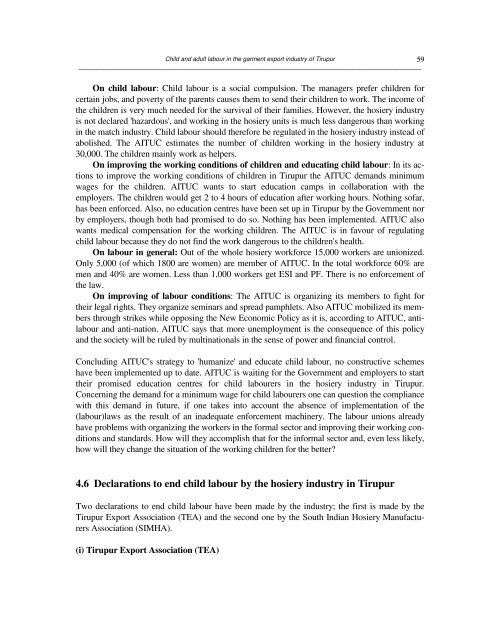You also want an ePaper? Increase the reach of your titles
YUMPU automatically turns print PDFs into web optimized ePapers that Google loves.
<strong>Child</strong> <strong>and</strong> <strong>adult</strong> <strong>labour</strong> <strong>in</strong> <strong>the</strong> <strong>garment</strong> <strong>export</strong> <strong>in</strong>dustry <strong>of</strong> Tirupur<br />
──────────────────────────────────────────────────────────────────────────────────────────────<br />
On child <strong>labour</strong>: <strong>Child</strong> <strong>labour</strong> is a social compulsion. The managers prefer children for<br />
certa<strong>in</strong> jobs, <strong>and</strong> poverty <strong>of</strong> <strong>the</strong> parents causes <strong>the</strong>m to send <strong>the</strong>ir children to work. The <strong>in</strong>come <strong>of</strong><br />
<strong>the</strong> children is very much needed for <strong>the</strong> survival <strong>of</strong> <strong>the</strong>ir families. However, <strong>the</strong> hosiery <strong>in</strong>dustry<br />
is not declared 'hazardous', <strong>and</strong> work<strong>in</strong>g <strong>in</strong> <strong>the</strong> hosiery units is much less dangerous than work<strong>in</strong>g<br />
<strong>in</strong> <strong>the</strong> match <strong>in</strong>dustry. <strong>Child</strong> <strong>labour</strong> should <strong>the</strong>refore be regulated <strong>in</strong> <strong>the</strong> hosiery <strong>in</strong>dustry <strong>in</strong>stead <strong>of</strong><br />
abolished. The AITUC estimates <strong>the</strong> number <strong>of</strong> children work<strong>in</strong>g <strong>in</strong> <strong>the</strong> hosiery <strong>in</strong>dustry at<br />
30,000. The children ma<strong>in</strong>ly work as helpers.<br />
On improv<strong>in</strong>g <strong>the</strong> work<strong>in</strong>g conditions <strong>of</strong> children <strong>and</strong> educat<strong>in</strong>g child <strong>labour</strong>: In its actions<br />
to improve <strong>the</strong> work<strong>in</strong>g conditions <strong>of</strong> children <strong>in</strong> Tirupur <strong>the</strong> AITUC dem<strong>and</strong>s m<strong>in</strong>imum<br />
wages for <strong>the</strong> children. AITUC wants to start education camps <strong>in</strong> collaboration with <strong>the</strong><br />
employers. The children would get 2 to 4 hours <strong>of</strong> education after work<strong>in</strong>g hours. Noth<strong>in</strong>g s<strong>of</strong>ar,<br />
has been enforced. Also, no education centres have been set up <strong>in</strong> Tirupur by <strong>the</strong> Government nor<br />
by employers, though both had promised to do so. Noth<strong>in</strong>g has been implemented. AITUC also<br />
wants medical compensation for <strong>the</strong> work<strong>in</strong>g children. The AITUC is <strong>in</strong> favour <strong>of</strong> regulat<strong>in</strong>g<br />
child <strong>labour</strong> because <strong>the</strong>y do not f<strong>in</strong>d <strong>the</strong> work dangerous to <strong>the</strong> children's health.<br />
On <strong>labour</strong> <strong>in</strong> general: Out <strong>of</strong> <strong>the</strong> whole hosiery workforce 15,000 workers are unionized.<br />
Only 5,000 (<strong>of</strong> which 1800 are women) are member <strong>of</strong> AITUC. In <strong>the</strong> total workforce 60% are<br />
men <strong>and</strong> 40% are women. Less than 1,000 workers get ESI <strong>and</strong> PF. There is no enforcement <strong>of</strong><br />
<strong>the</strong> law.<br />
On improv<strong>in</strong>g <strong>of</strong> <strong>labour</strong> conditions: The AITUC is organiz<strong>in</strong>g its members to fight for<br />
<strong>the</strong>ir legal rights. They organize sem<strong>in</strong>ars <strong>and</strong> spread pamphlets. Also AITUC mobilized its members<br />
through strikes while oppos<strong>in</strong>g <strong>the</strong> New Economic Policy as it is, accord<strong>in</strong>g to AITUC, anti<strong>labour</strong><br />
<strong>and</strong> anti-nation. AITUC says that more unemployment is <strong>the</strong> consequence <strong>of</strong> this policy<br />
<strong>and</strong> <strong>the</strong> society will be ruled by mult<strong>in</strong>ationals <strong>in</strong> <strong>the</strong> sense <strong>of</strong> power <strong>and</strong> f<strong>in</strong>ancial control.<br />
Conclud<strong>in</strong>g AITUC's strategy to 'humanize' <strong>and</strong> educate child <strong>labour</strong>, no constructive schemes<br />
have been implemented up to date. AITUC is wait<strong>in</strong>g for <strong>the</strong> Government <strong>and</strong> employers to start<br />
<strong>the</strong>ir promised education centres for child <strong>labour</strong>ers <strong>in</strong> <strong>the</strong> hosiery <strong>in</strong>dustry <strong>in</strong> Tirupur.<br />
Concern<strong>in</strong>g <strong>the</strong> dem<strong>and</strong> for a m<strong>in</strong>imum wage for child <strong>labour</strong>ers one can question <strong>the</strong> compliance<br />
with this dem<strong>and</strong> <strong>in</strong> future, if one takes <strong>in</strong>to account <strong>the</strong> absence <strong>of</strong> implementation <strong>of</strong> <strong>the</strong><br />
(<strong>labour</strong>)laws as <strong>the</strong> result <strong>of</strong> an <strong>in</strong>adequate enforcement mach<strong>in</strong>ery. The <strong>labour</strong> unions already<br />
have problems with organiz<strong>in</strong>g <strong>the</strong> workers <strong>in</strong> <strong>the</strong> formal sector <strong>and</strong> improv<strong>in</strong>g <strong>the</strong>ir work<strong>in</strong>g conditions<br />
<strong>and</strong> st<strong>and</strong>ards. How will <strong>the</strong>y accomplish that for <strong>the</strong> <strong>in</strong>formal sector <strong>and</strong>, even less likely,<br />
how will <strong>the</strong>y change <strong>the</strong> situation <strong>of</strong> <strong>the</strong> work<strong>in</strong>g children for <strong>the</strong> better?<br />
59<br />
4.6 Declarations to end child <strong>labour</strong> by <strong>the</strong> hosiery <strong>in</strong>dustry <strong>in</strong> Tirupur<br />
Two declarations to end child <strong>labour</strong> have been made by <strong>the</strong> <strong>in</strong>dustry; <strong>the</strong> first is made by <strong>the</strong><br />
Tirupur Export Association (TEA) <strong>and</strong> <strong>the</strong> second one by <strong>the</strong> South <strong>India</strong>n Hosiery Manufacturers<br />
Association (SIMHA).<br />
(i) Tirupur Export Association (TEA)


















